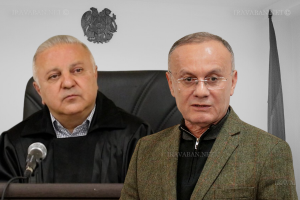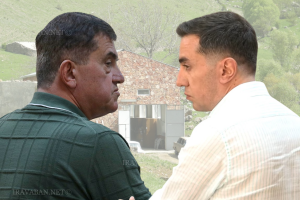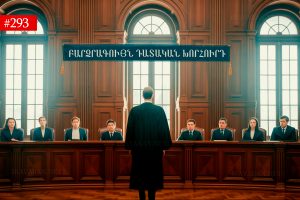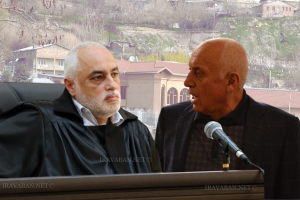The Constitutional Court published on September 27 the decision on the compliance of the regulation on state border delimitation between Armenia and Azerbaijan with the Constitution.
The decision also refers to the Declaration of Independence. Iravaban.net spoke with Constitutional Court Judge Edgar Shatiryan about the topic.
“Checking the constitutionality of obligations enshrined in international treaties is the exclusive constitutional authority of the Constitutional Court. Within this framework, clarifying the scope of circumstances to be determined in each case subject to examination in the Constitutional Court is exclusively within the jurisdiction of the Constitutional Court, or at least the majority of judges, who then adopt the corresponding draft decision based on the voting results. Let me note: what issues to address, what issues not to address, is decided exclusively by the Constitutional Court,” our interlocutor said.
According to the Constitutional Court judge, the 1991 Alma-Ata Declaration contains a formulation that the Republics of Armenia and Azerbaijan mutually recognize each other’s territorial integrity and inviolability of borders.
“There is a clear provision that the commissions are based on the 1991 Alma-Ata Declaration as a fundamental principle for the process of state border delimitation between Armenia and Azerbaijan. Of course, there is also an ‘if’ in parentheses. Essentially, you mentioned the formulation ‘existing border’ which is reflected in the Alma-Ata Declaration, a declaration referenced in the joint activity regulation. Regarding the Declaration of Independence, there is a mention of this declaration in the preamble of the Armenian Constitution, and the Constitutional Court addressed this issue in the following context: The Declaration of Independence establishes nationwide principles and national goals. Why? Because the preamble of the Declaration of Independence also mentions the reunification of the Armenian SSR and Nagorno-Karabakh, the joint decision of the Supreme Council of the Armenian SSR and the National Council of Nagorno-Karabakh. In this regard, considering that the regulation essentially relates to territory, border, similar formulations, the Constitutional Court deemed it necessary to address the following question: Do the principles underlying the determination of Armenia’s territory envisaged by the regulation correspond to the Constitution, considering the formulation of existing borders used in the Alma-Ata Declaration?” said Edgar Shatiryan.
Addressing the formulation “The Declaration can turn into a parent devouring its children,” he noted that when addressing this formulation, it’s important not to distort the content of the Constitutional Court’s decision.
“This formulation is found in the context that the Constitutional Court, analyzing the formulation of fundamental principles of Armenian statehood and national goals provided or established in the declaration, has come to a corresponding conclusion in terms of content, if I were to formulate it in one or two sentences, it is as follows: The dual sovereignty of the Constitution within the state is fraught with numerous dangers, therefore, for the sake of ensuring constitutional security and stability, the provisions establishing the fundamental principles of Armenian statehood and national goals established in the Declaration of Independence have the legal force of Constitutional provisions to the extent that they are reflected in the text of the Constitution. This by no means implies that the Declaration of Independence has been diminished. Moreover, it does not mean that it has been annulled. No one, no person, no subject, including the Constitutional Court, is authorized to annul the Declaration of Independence of Armenia,” he noted.
Edgar Shatiryan said he has no intention of diminishing the declaration, but there are a few observations about it.
“This was adopted by the Supreme Council of the Armenian SSR. The 1995 Constitution was adopted by the Armenian people through a nationwide referendum held in the territory of the Republic of Armenia. The Declaration of Independence did not declare Armenia’s independence, but declared the beginning of the process of establishing independent statehood. And the declaration, containing 12 points, clearly stipulated in the 12th point that this declaration is, among other things, also the basis for the development of a new Constitution. On July 5, 1995, the Constitution of the Republic of Armenia was adopted, which came into force on July 13 of the same year. Yes, until then, the declaration had, so to speak, the force and influence of a supra-constitutional act, but from the moment the 1995 Constitution came into force, the provision of the second sentence of Article 6 of the Constitution also came into force, stating that the Constitution has supreme legal force and its norms act directly,” said the Constitutional Court judge.
Addressing the question of why this particular decision of the Constitutional Court became the subject of such wide discussions, Edgar Shatiryan said that there are disagreements and that’s normal.
“For all those people who discuss the Constitutional Court’s decision with honest motives, who don’t pursue other motives, I have nothing to say to them, I respect their opinion, although I was in favor of the position reflected in the Constitutional Court’s decision. There are specific circles who, X time after the publication of the decision, almost synchronously raised a noise and tried to make this noise bigger through transmissions. The goal is to generate public outrage,” said the Constitutional Court judge.
Addressing the rally of the “Sacred Struggle” movement in front of the Constitutional Court, Edgar Shatiryan said that he invites the attention of the relevant bodies to the actions that took place.
“Not only to such actions, but also to the statements made in the media, so-called interviews. They have allowed themselves such an expression: what does it mean ‘we show a yellow card to the Constitutional Court’, is this a threat, are they bullying the Constitutional Court? If so, I also retort with the same phrase – a large segment of the public has long shown a red card to many of them. Maybe some will be shown in the near future,” he said.
More details are in the video.














